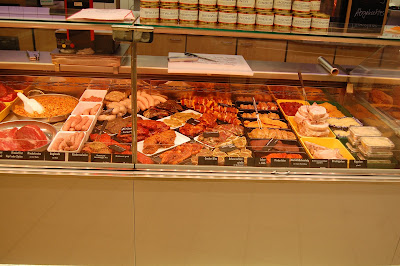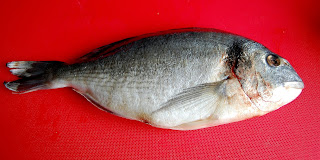Whilst on my recent
trip to Germany I needed to find (no – not a loo this time - that's another story) a place
that sold newspapers. The Badische Neueste Nachrichten – a locally
respected newspaper in Karlsruhe – had favourably published two
theatre reviews of the Lace Market Theatre productions of Michael
Frayn's Benefactors and W. Shakespeare's A Midsummer Night's Dream.
From a few previous visits to Karlsruhe I remembered the location of
what turned out to be a branch of the Cap chain of mini supermarkets
and so I trekked down Kaiser Allée
in search of this establishment and its excellent car parking
facilities in front of the store. That's my sponsorship fee sorted.
It was easy enough to
find. Once inside I found myself distracted by the dried Spätzle
products and fascinated by the German names for the dried herbs on
offer as well as the lip smacking abundance of delicious smoked meats
to tempt the tongue and the senses. Maybe that should be lippen
schmakking although my schpellchecker now alerts me to bad
schpelling. Bad Schpelling? Now that sounds like a spa town in southern
Bavaria. I move on... Los Geht's...
During my perusal of
the mini-markt I happened to halt by the meat counter and asked the
lady if I could take some photos. She looked a bit freaked out by my
request and wasn't overly placated by my admittance/confession of
being English and also a worker behind a similar counter at Tesco.
Perhaps I should have pronounced my employers name as Teschco. After
a few awkward moments there was a momentary concession to photos
being taken. However, it was abundantly clear that Frau Cap did not
want to appear in my blog post. In fact the middle aged lady pretty much ran away
as soon as I whipped out my equipment! Such is the proverbial story
of my life.
The counter looked very
similar to any English supermarket meat counter with a few clear
exceptions. There were recognisable cuts but also quite a big section
of marinated meat products adding colour and interest and some of the
bigger non-marinated joints showed darker elements of meat cutting
and ageing that would be dismissed by many British customers buying
meat in a supermarket. Sadly, at home there is still this ignorant
illusion that meat is some kind of plastic product that looks
perfectly pink/red all of the time and if there appears to be any
sort of natural discolouration in the flesh then this is something to
worry about or query about in terms of freshness.
Part of me wishes that
my German language was a greater level and that I would have been
able to have a lovely chat with Frau Cap on the supermarket meat
counter. Not quite busman's holiday chit chat but something akin to
this and perhaps something I could have gained knowledge from and
shared it with my readers. Alas Frau Cap stayed hidden behind the
scenes until the scary English nutcase had gone from sight and she
was able to return to her job of fondling the Wurstle (little
sausages).
On picking up one the
supermarket's free promotional leaflets I was marginally interested
to see that they had pre-packed meat products just the same as in the
UK but with regional differences like the mixed beef and pork stew
pack (Gulasch-gemischt) for Goulash and the fatty pork shoulder steaks had the more
prosaic and slightly Sweeney Todd description of Pig Throat Steaks. “Ja,
I would like some of your cut throat pork steaks (Schweine Hals-Kotelett) please, Herr Todd.
They are for a big juicy pie I am making.”








































